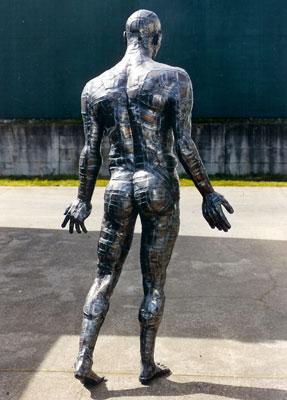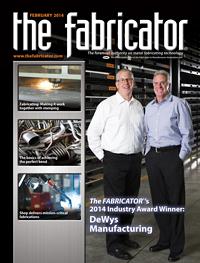- FMA
- The Fabricator
- FABTECH
- Canadian Metalworking
Categories
- Additive Manufacturing
- Aluminum Welding
- Arc Welding
- Assembly and Joining
- Automation and Robotics
- Bending and Forming
- Consumables
- Cutting and Weld Prep
- Electric Vehicles
- En Español
- Finishing
- Hydroforming
- Laser Cutting
- Laser Welding
- Machining
- Manufacturing Software
- Materials Handling
- Metals/Materials
- Oxyfuel Cutting
- Plasma Cutting
- Power Tools
- Punching and Other Holemaking
- Roll Forming
- Safety
- Sawing
- Shearing
- Shop Management
- Testing and Measuring
- Tube and Pipe Fabrication
- Tube and Pipe Production
- Waterjet Cutting
Industry Directory
Webcasts
Podcasts
FAB 40
Advertise
Subscribe
Account Login
Search
Art for art's sake
Sculptor relies on viewer to interpret sculptures, find meaning in art
- By Eric Lundin
- February 10, 2014
- Article
- Shop Management
If you look at a piece of artwork or a collection of pieces long enough, you’ll learn a little about the artist. You might learn about a social perspective or a political position, and you’ll learn a bit about his technique. Some artists revel in this, but some artists try to remove as much of themselves as possible from their work. At the height of his popularity, Jackson Pollock abandoned the style that made him famous, and toward the end of his career, he stopped giving titles to his paintings and merely numbered them. This sort of thing forces the viewer to take a little extra time and look a little deeper. If the work is truly inspirational, the viewer goes beyond wondering what the artist was thinking and looks inward to find meaning in the work.
This is what Roy Mackey strives to achieve.
130 Percent of Roy
Mackey learned metalworking by buying old cars, doing body work to fix them up, and selling them. Eventually he learned to do the paint work, and along the way he developed an appreciation for cutting, shaping, and finishing steel.
In his free time he took up drawing, mainly faces, and realized that a face could be rendered as a large collection of flat surfaces. Mackey combined his passion for metals with his inspiration to create faces and tried his hand at making one from metal. He liked the outcome and was hooked.
Over the years projects and jobs came and went, and Mackey noticed a frustrating dichotomy. When he had a full-time job he had plenty of money for tools and materials but no time for metalworking; when he had a part-time job, he had plenty of time but little money. A near-fatal motorcycle accident made Mackey realize that life was too short to mess around with a series of jobs that didn’t make him happy, and he became a full-time artist.
A recent project, one he started with more than two decades of artwork under his belt, is “Naked Man,” a 3-D self-portrait in sheet metal. He used small pieces of 20-gauge steel cut from sheet and shaped by hand. The result isn’t just a 130 percent-sized replica of Mackey in midstride; it’s a deceptively formed, perfectly balanced, self-supporting exoskeleton.
“Most people think I hammered the pieces, but I didn’t—just bent them by hand,” Mackey said. “It doesn’t have an armature in the center for support or ballast in the feet for stability or anything like that. When you look at it, you see everything. It’s completely hollow. It’s pretty lightweight and easy to move, yet it’s also well-balanced and stable.”
The Nail Gets Even
Like many artisans, he doesn’t just use tools. He loves tools. He relies heavily on an eclectic collection of antique and vintage tools he has collected over the years.
Tools are such a big part of Mackey’s life that sometimes he sees the world through a tool’s perspective. A hammer—forged, sturdy, and massive—puts a nail where the carpenter wants it, and the nail doesn’t resist. Mackey wondered what would happen if the nail had the upper hand, at least once. The result is “Revenge,” a hammer that appears to be pierced by a nail and bleeding. Mackey liked the result, and a series was born. One has two faces and four claws. Another appears to have had its face split by the nail’s impact. One is combined with a wire brush, which appears to be a Mohawk.
“I made one that has a small towing hook built into it,” Mackey said. “My brother put it on display in his auto parts shop, and once in a while a tow-truck driver sees it and asks what it is, thinking it’s a real tool, but he can’t figure out what it’s for.”

“Naked Man”, approximately 8 feet tall, is a self-portrait of metal sculptor Roy Mackey. Rather than work from a drawing, he based the sculpture on an immense number of measurements of his body’s dimensions.
An Introspective Perspective
The bewildered expressions make the tow-hook hammer worthwhile, but they also reveal how Mackey views his work.
“If you held it in your hand, and you swung it side to side a bit to make the hook rotate back and forth on its swivel, you’d wonder what it was for,” Mackey said. “It looks like a real tool, and nobody would expect that someone would spend all this time and effort to make something so useless. In our society, you have to have a reason to do things, and everything follows a logical sequence, and everything has to have an order. When you finally realize that it’s really nothing, you see that it’s really an intriguing piece, and your mind stops trying to figure out what it is. It quiets the mind a bit.”

“Revenge” (left) was Mackey’s first modified hammer. This led to a series of hammers, many of which have modifications that are deliberately useless. Two of the other hammers in the series, “Sweater” (middle) and “Double Header” (right), make the point. A bank in downtown Vancouver had a collection of Mackey’s pieces similar to these in its art showcase, and the building manager later confided in Mackey that in his 15 years at the bank, he had never seen so many people stop and linger to look at the artwork.
About the Author

Eric Lundin
2135 Point Blvd
Elgin, IL 60123
815-227-8262
Eric Lundin worked on The Tube & Pipe Journal from 2000 to 2022.
subscribe now

The Fabricator is North America's leading magazine for the metal forming and fabricating industry. The magazine delivers the news, technical articles, and case histories that enable fabricators to do their jobs more efficiently. The Fabricator has served the industry since 1970.
start your free subscription- Stay connected from anywhere

Easily access valuable industry resources now with full access to the digital edition of The Fabricator.

Easily access valuable industry resources now with full access to the digital edition of The Welder.

Easily access valuable industry resources now with full access to the digital edition of The Tube and Pipe Journal.
- Podcasting
- Podcast:
- The Fabricator Podcast
- Published:
- 04/16/2024
- Running Time:
- 63:29
In this episode of The Fabricator Podcast, Caleb Chamberlain, co-founder and CEO of OSH Cut, discusses his company’s...
- Trending Articles
AI, machine learning, and the future of metal fabrication

Employee ownership: The best way to ensure engagement

Steel industry reacts to Nucor’s new weekly published HRC price

Dynamic Metal blossoms with each passing year

Metal fabrication management: A guide for new supervisors

- Industry Events
16th Annual Safety Conference
- April 30 - May 1, 2024
- Elgin,
Pipe and Tube Conference
- May 21 - 22, 2024
- Omaha, NE
World-Class Roll Forming Workshop
- June 5 - 6, 2024
- Louisville, KY
Advanced Laser Application Workshop
- June 25 - 27, 2024
- Novi, MI



























